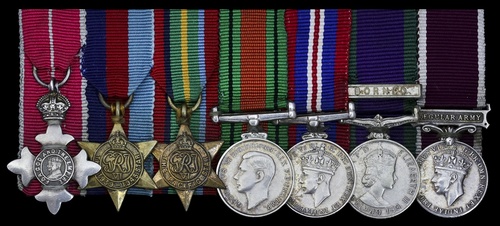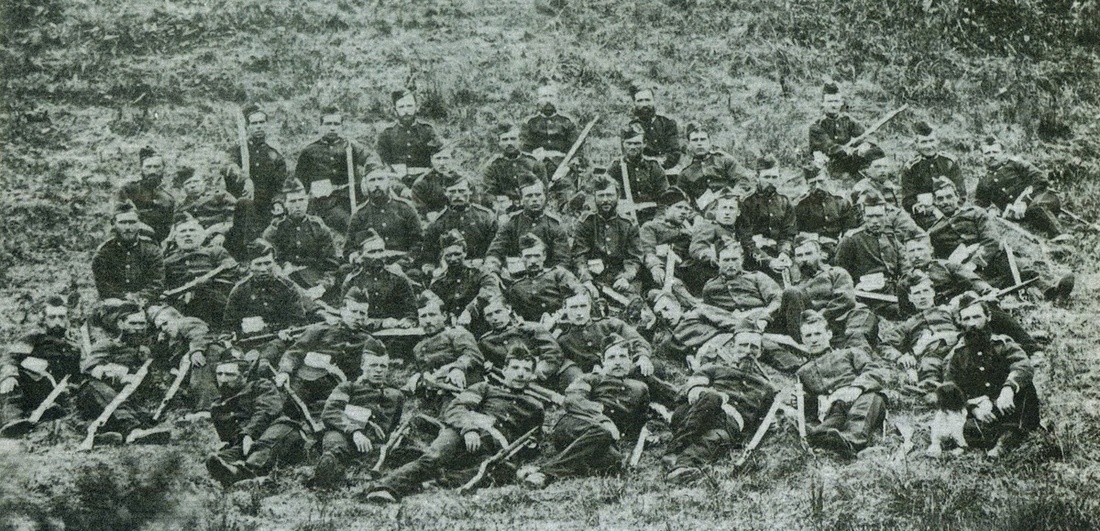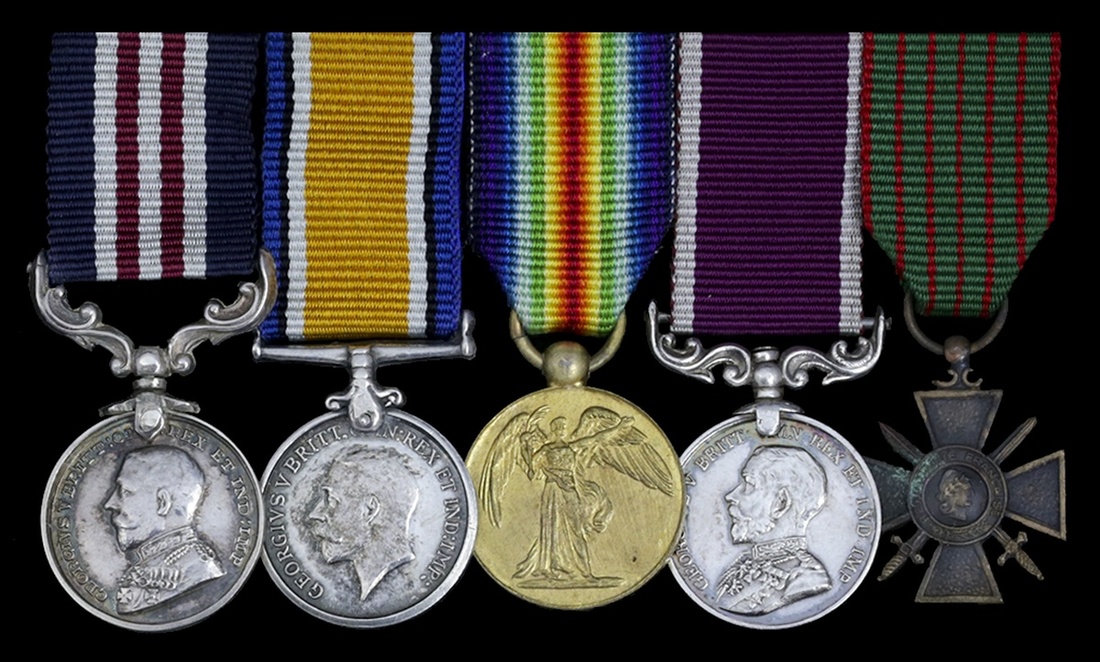Auction: 19001 - Orders, Decorations and Medals
Lot: 1029
Family group:
An important mounted group of three miniature dress medals worn by Garrison Sergeant-Major H. E. Gallagher, 24th Foot (South Wales Borderers), who commanded the South Barricade at Rorke's Drift and was the second-most senior N.C.O. present on that famous occasion
South Africa 1877-79, 1 clasp, 1877-8-9; India General Service 1854-95, 1 clasp, Burma 1887-9; Meritorious Service Medal, G.V.R., mounted upon their original wearing pin, good very fine, together with an old length of silk riband for the South Africa 1877-79 Medal
The mounted group of five miniature dress medals worn by Transport Warrant Officer Class I J. N. Lane, Royal Engineers
Military Medal, G.V.R.; British War and Victory Medals; Army L.S. & G.C., G.V.R.; France, Croix de Guerre, reverse dated '1914-1918', mounted upon their original wearing pin, good very fine
The mounted group of seven miniature dress medals worn by Major E. H. Lane, Royal Engineers
The Most Excellent Order of the British Empire, 2nd type M.B.E. Badge; 1939-45 Star; Pacific Star; Defence and War Medals 1939-45; General Service 1962-2007, 1 clasp, Borneo; Army L.S. & G.C., G.VI.R., Regular Army, mounted court-style as worn, good very fine (15)
Provenance:
Acquired from the grandaughter of Major E. H. Lane, Royal Engineers, himself the grandson of Garrison Sergeant-Major H. Gallagher, 24th Foot. Sold with a print of Rorke's Drift (signed and numbered 25/1000) by Mark Churms, annotated 'To the Lane Family, descendents of Sgt. Gallagher, MC 96' and a letter stating:
'These are the minitures [sic] of Sgt Henry Gallagher of the 2nd/24th Warwickshire Regiment of Foot, who was a defender of Rorke's Drift. They were in the collection of Roger Lane, Henrys great grandson. Roger was my father and Henry was my great, great, grandfather.'
Henry Edward Gallagher was born in March 1855 at Killinane, Thurles, Count Tipperary and enlisted in the 24th Foot at Brecon, South Wales in March 1874, being assigned to ‘B’ Company, 2nd Battalion. He had been advanced to Sergeant by October 1877 and the time of the embarkment to South Africa.
Subsequently among those members of ‘B’ Company assigned to guard duties at Rorke’s Drift, he was one of five N.C.Os, under Colour-Sergeant Frank Bourne, his immediate senior, who made their way up to the hills behind the mission station in the afternoon of 22 January 1879, from which vantage point they heard the pounding of artillery coming from Isandhlwana and saw clouds of smoke, which facts they reported on their return. Later that the same afternoon, their fears were confirmed by the arrival of a panic-stricken Trooper, fresh from scenes of a massacre.
In the legendary action that followed Gallagher himself was in charge of the south wall, the barricade for which included two wagons, the whole manned by several sharpshooters. Major E. H. Lane (also included in Lot), later recalled:
‘My grandfather gave graphic pictures of the defence of Rorke’s Drift and the way in which ‘B’ Company withstood the attacks so fearlessly. He remembered the initial horror felt at the sight of the first wave of the attack as so many Zulus in battle array came down on them. But as the fighting progressed all fear left him because he was so busy shooting. He was in charge of the south wall of bags and wagons, and was later stationed in the mealie-bag redoubt. All the defenders were in a state of collapse when the fighting was done. He carried the scars of the defence with a permanent blue mark on the right side of his nose, which was a powder burn caused by the backflash each time he fired his rifle.'
Subsequently employed in the Burma operations of 1887-88, he was hospitalised for a month at Aden in 1893, with ‘severe wear of the foot’, but on returning to England that November, he was permitted to extend his service beyond 21 years. He was finally discharged back at Gosport in May 1897, after 23 years and found employment as Barrack Warden at Portsmouth. He was also awarded the Meritorious Service Medal in Army Orders of 1910, with an annuity of £10. Major Lane continues:
'I remember him from about 1919-20 until his death. During that period I regularly spent two or three weeks annually at his home in Augustine Road [“Wisteria” at Drayton, Hampshire]. He was very fond of his grandchildren, and we loved him. He had a great sense of humour and a real Irish sense of fun. When I first got to know him he would tell me stories of his soldiering, especially South Africa and Rorke’s Drift in particular. He was proud of his regiment, the Twenty-Fourth, and maintained his soldierly smartness and appearance all his life. He was a great story-teller on any subject true or fictitious. He was very fond of walking, especially on the Portsdown Hill. We would walk many miles on what he called “campaigning”, me asking him questions, and he giving the answers - which I fully believed. But sometimes his deliberate exaggerations gave the clue that it was all his “Irish blarney” coming out. He loved his small garden, where he grew most of his vegetables and kept chickens. He died very suddenly in 1931, when strangely, I was stationed with the Royal Engineers in Ireland, quite close to Thurles, and from where I kept up a correspondence with him.’
Gallagher died on 17 December 1931 and was buried with full military honours at Christ Church, Portsdown Hill, Cosham, Hampshire.
M.M. London Gazette 17 June 1919 (North Russia).
Croix de Guerre London Gazette 9 October 1919.
Josiah Nathaniel Lane was born on 17 June 1883 and married the daughter of Garrison Sergeant-Major H. E. Gallagher in 1906.
M.B.E. London Gazette 13 June 1957.
Edward Horace Lane was born in 1912, the son of Transport Warrant Officer Class I J. N. Lane. He served with the Royal Engineers during the Second World War and latterly in the Borneo operations and died in 2003.
Subject to 20% VAT on Buyer’s Premium. For more information please view Terms and Conditions for Buyers.
Sold for
£5,000











